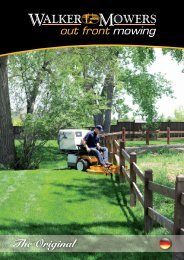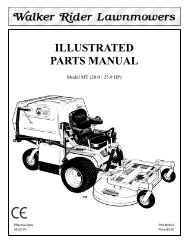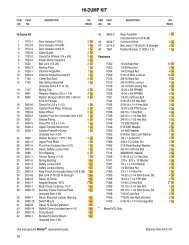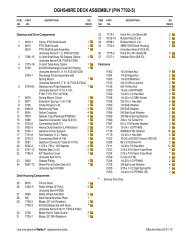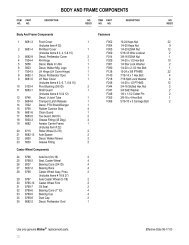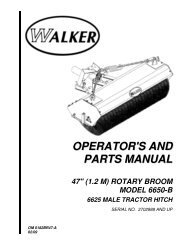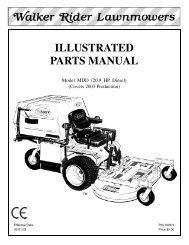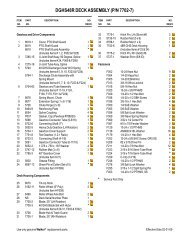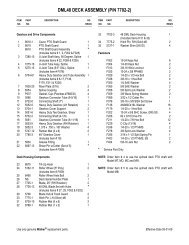1998 S/N 21329 - Walker Mowers
1998 S/N 21329 - Walker Mowers
1998 S/N 21329 - Walker Mowers
Create successful ePaper yourself
Turn your PDF publications into a flip-book with our unique Google optimized e-Paper software.
Maintenance Instructions<br />
CHECKING/SERVICING<br />
3. Replace filler caps.<br />
IMPORTANT: DO NOT overfill the battery. Electrolyte<br />
will overflow through the vented caps onto parts<br />
of the machine and WILL result in severe corrosion.<br />
Cleaning the Terminals<br />
If battery terminals are corroded, remove battery<br />
from the mower. Using a wire brush, remove corrosion<br />
with a solution of one part baking soda and<br />
four parts water. Rinse with clean water. Coat the<br />
terminals with petroleum jelly or terminal protector<br />
spray to retard further corrosion.<br />
Charging the Battery<br />
Check the battery charge by measuring the specific<br />
gravity of electrolyte; if specific gravity is less than<br />
1.225, the battery will need to be charged as follows:<br />
1. Charge the battery at 15 amps for 10 minutes.<br />
DO NOT exceed 20 amps maximum recommended<br />
charging rate. Charge until specific<br />
gravity is at least 1.250. Total charging time<br />
should not exceed one (1) hour.<br />
2. After charging the battery, use drinking water to<br />
adjust the electrolyte level to the bottom of the<br />
vent wells [1/4 to 1/2 in. (6 to 13 mm) above the<br />
plates].<br />
DANGER<br />
BATTERIES PRODUCE EXPLOSIVE<br />
GASES<br />
• Charge the battery in a well-ventilated<br />
area, so that gases produced while charging<br />
can dissipate.<br />
• Keep sparks, flames, and smoking materials<br />
away from the battery at all times.<br />
• Make sure the battery cap vents are open<br />
(check manifold vent on each cap).<br />
• Make sure the battery charger is unplugged<br />
before connecting or disconnecting<br />
cables to the battery.<br />
Tire Pressure<br />
Inflate tires to pressures shown below:<br />
Deck Caster Wheel = 20 PSI (137 kPa)<br />
Drive = 15 PSI (103 kPa)<br />
Rear = 20 PSI (137 kPa)<br />
Sharpen Mower Blades<br />
Check mower blade(s) for straightness, sharpness,<br />
condition of the cutting edge, and balance<br />
every 10 hours of operation (or more often when<br />
mowing abrasive type grass or operating on sandy<br />
soils). Replace blades if worn, bent, cracked, or<br />
otherwise damaged (refer to REPLACING/RE-<br />
PAIRING the Mower Blades in this section). Use the<br />
following procedure to check and sharpen blades:<br />
NOTE: Keep blades sharp - cutting with dull<br />
blades not only yields a poor mowing job but slows<br />
the cutting speed of the mower and causes extra<br />
wear on the engine and blade drive by pulling hard.<br />
1. Stop the engine, remove ignition key, and disconnect<br />
the spark plug wires before raising the<br />
mower deck to service blades.<br />
2. Raise the deck and secure it in either the UP position<br />
using the deck lift rod (non-tilt deck) or in<br />
the TILT-UP position. Refer to CLEANING the<br />
Grass Buildup in Mower Housing in this section<br />
for deck raising instructions.<br />
DANGER<br />
NEVER operate cutter blades with the<br />
deck in the raised position.<br />
3. Check the blades for straightness by marking<br />
the blade tip position inside the deck housing,<br />
and then rotating the opposite end of the blade<br />
to the same position and comparing. If the difference<br />
in blade tip track is more than 1/8 in.<br />
(3 mm), the blade is bent and should be replaced.<br />
61



